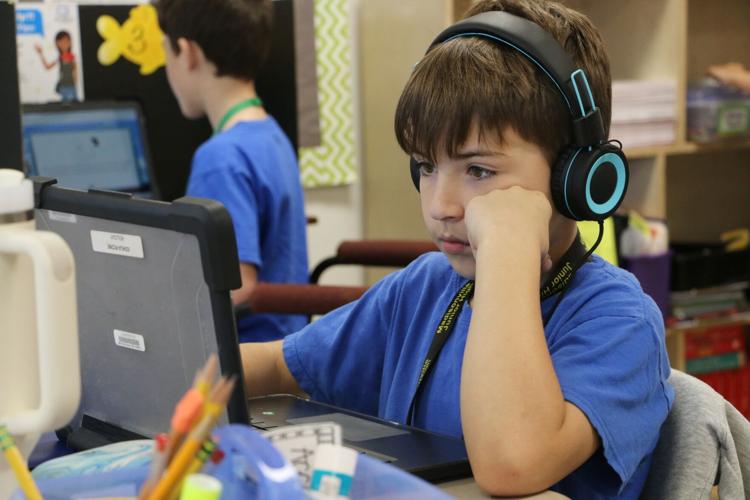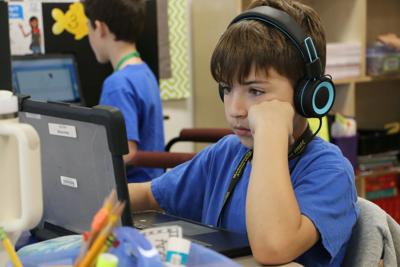On a recent morning at Madisonville Elementary School, while a kindergarten teacher read to students on the carpet, a boy sat at a back table working with a tutor named Amira.
Amira asked the St. Tammany Parish student to read a series of words — dad, dig, dot. Then came sentences: “The dog digs to the top.” “The dad is mad.” When the boy stumbled on a word, Amira showed him how to sound it out. “Great work!” Amira said when the lesson concluded.
It was a standard tutoring session — except for the fact that Amira is not human, but artificial intelligence.
As Louisiana looks to jumpstart students’ ongoing academic recovery from the pandemic, policymakers want to go big on tutoring. State Superintendent of Education Cade Brumley recently requested $30 million from the legislature to “vastly expand” in-school tutoring. And a new bill, filed last Friday, would require schools to provide intensive tutoring to students in kindergarten through 12th grade who test below grade level.

The Amira A.I. tutoring program listens to students read and helps them sound out words that stump them.
But in the race to ramp up tutoring, Louisiana faces a riddle that has stumped other states: How to offer individual support to tens of thousands of students without busting the budget or sacrificing quality? That's where A.I. comes in.
Experts caution that the research on computer-based tutoring is still inconclusive, and A.I. can’t build relationships with students like human tutors can. Still, early data suggest some computer tutoring programs can improve student learning at a fraction of the cost of human tutoring.
Now, Brumley wants to make A.I. one of several options schools can choose from to expand tutoring. Recently, he recalled seeing a demonstration of Amira and thinking it could bypass some of the funding and staffing hurdles associated with in-person tutors.
“The things that are happening with this technology,” he said, “are things that I've been looking for as a solution for a long time.”
Computerized tutoring cuts costs but has drawbacks
After the pandemic set back millions of students academically, experts promoted tutoring as among the best ways to catch kids up.
Studies have shown that effective tutoring can give students a learning boost equivalent to many months of schooling. But the tutoring must be “high-dosage,” with well-trained tutors working with groups of four or fewer students multiple times a week during the school day.

Louisiana Superintendent of Education Cade Brumley said that A.I. programs could help schools expand tutoring at a lower cost and with fewer staffers than traditional programs.
Such intensive support can be hard for schools to schedule, staff and afford, even with federal pandemic-relief money. Those challenges have cramped the spread of high-dosage tutoring, which only 11% of students nationally received last fall, according to a federal survey.
Now, many schools are turning to technology to fill in gaps in academic support. Adaptive computer programs can simulate tutoring by adjusting lessons and giving customized feedback based on student responses. Amira Learning, a for-profit company whose reading software builds on research conducted at Carnegie Mellon University, is one of several ed-tech firms marketing A.I.-powered tutoring programs.
The companies say their technology can dramatically reduce costs while serving more students than traditional tutors. Amira, for example, costs about $20 per student, compared with up to $3,000 per student for intensive human tutoring.
“We think they have an excellent opportunity to make a real impact,” said Kevin Huffman, CEO of Accelerate, a nonprofit working to expand effective tutoring. The group awarded Louisiana $1 million to experiment with in-person and virtual tutoring programs, including BookNook for reading and Zearn for math.
Some studies of adaptive computer programs — also called “personalized learning” technology — show positive student outcomes. But other research has found mixed results, often depending on how schools deploy the technology.
A recent study in Utah found that students in grades K-3 who used adaptive reading programs, including Amira, for the recommended amount of time saw their reading scores improve. The challenge was that most students didn’t meet the recommendations. For example, students used Amira an average of 19 minutes per week for 15 weeks rather than the recommended 30 weekly minutes for 30 weeks.
“These tutoring programs are only effective if kids actually do the sessions,” Huffman said.
One promising strategy is for students to alternate days with human and computer tutoring. A study in seven high schools found the hybrid approach boosted learning nearly as much as daily human tutoring while cutting costs and reducing staff needs.
Carly Robinson, research director of the National Student Support Accelerator at Stanford University, which studies tutoring, said adaptive and A.I.-powered tutoring programs show great potential. But she also noted that relationship-building is a key component of effective tutoring that keeps students motivated and engaged.
“Fostering human connections is not one of the things that A.I. can do,” she said. “I’m not sure we’ll ever be able to replace the human in that equation.”
Louisiana’s experiment with A.I. tutors
Louisiana has embraced tutoring as a key remedy for pandemic learning loss.
Lawmakers passed a bill last year, which took effect in August, that requires schools to offer extra support to students in grades 3-8 who score below the “mastery” level in state reading or math tests. The support could include assigning students to the classroom of a high-rated teacher or providing small-group instruction during or after school.

While some students in a fourth-grade English language arts class use an A.I. tutoring program, others work independently or meet with their teacher.
Now that bill’s lead sponsor, Sen. Patrick McMath, wants the state to go even further. His latest proposal would mandate that low-scoring students in grades K-12 either be placed in a “highly effective” teacher’s classroom or provided with high-dosage tutoring. The tutoring must occur during school, three to five times a week, for at least 10 weeks.
Such a requirement would be incredibly expensive. One estimate put the price tag at $200 million annually, said Kelli Bottger, executive director of Louisiana Kids Matter, who has advised state lawmakers on tutoring. She noted that schools could use any remaining federal COVID aid for tutoring, though that money expires in September. She also said she expects the state board of education to endorse Brumley’s request for $30 million for tutoring in the state's school-funding formula, which the legislature must approve.
“There’s tons of research that high-dosage tutoring works and catches up kids better than anything else,” she said, adding that she's confident the board will support expanded tutoring.
The state education department already oversees several literacy tutoring programs, including grants for in-school tutoring and vouchers for private tutoring. Combined, the programs serve about 22% of struggling readers in grades K-5. Many schools run their own tutoring programs, but the state does not collect data on how many students participate.
Still, Brumley has acknowledged that it will be a “tremendous lift” to make tutoring available to every student in Louisiana who needs it. To do so, he wants to give schools a menu of options: pay school staffers to tutor, hire vendors to tutor in person or over video, or use tutoring software — including ones powered by A.I.
“You only have so many teachers and resources,” he said. “This is why A.I. might be part of the solution.”
Schools in St. Tammany Parish have gotten a glimpse of what A.I. tutoring can do.
The district piloted Amira’s A.I.-powered program with English learners before expanding it to all students in grades K-5 last fall. Last week, during Dana Holliday’s fourth-grade English language arts class at Lancaster Elementary, students took turns using Amira on laptops around the classroom.

When Amira's speech-recognition technology hears a student get stuck on a word, it plays a video showing how to sound out and say the word correctly.
Wearing headphones, they read stories aloud that appeared on screen line by line. If the program’s speech-recognition technology heard a student get stuck on a word, it showed the student a video of a person sounding out the word then saying it correctly. When the students finished, the program told them their reading speed and accuracy.
“It makes it fun for you,” said fourth-grader Lauren Burlette. “It will give you rewards, it will tell you how you're doing, and you get to pick whatever story you want.”
Holliday said the program gives her data about each student’s skills and gaps, which she uses to plan small-group lessons. It also can help students develop reading skills they might have missed during the pandemic.
“We're still dealing with COVID learning gaps,” she said. “It's hard to go back and teach those things one on one.”
About 2 million students nationwide use Amira, including about 74,000 students in Louisiana, said Amira Learning CEO Mark Angel. Now used in about 360 Louisiana schools, the goal is to make the program available statewide, he added.
Lancaster Principal Laura said her students and teachers have embraced Amira as a powerful tool. And according to data shared by Amira, students who use the program more than 30 minutes per week have made above-average reading gains.
“The computer can't replace the teacher,” Haggard said, “but this is pretty darn close.”
Editor's note: This story was updated March 5 to clarify that advocate Kelli Bottger said she expects the state board of education to support a request for tutoring funding.






